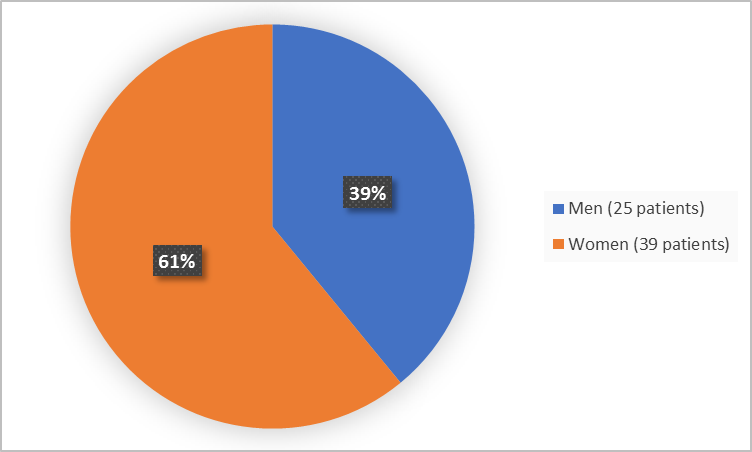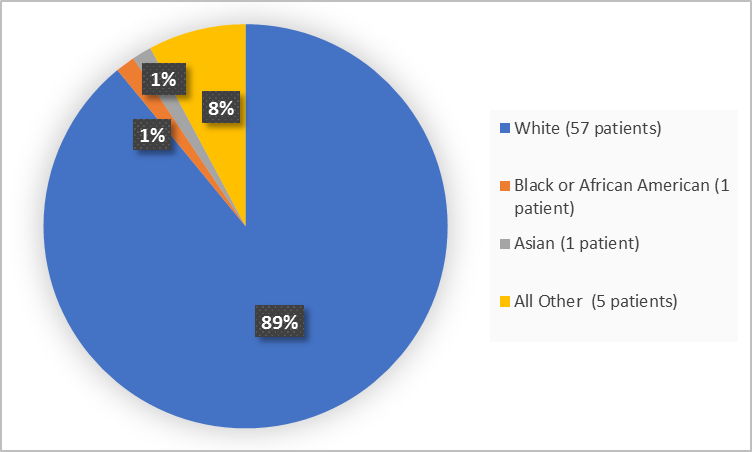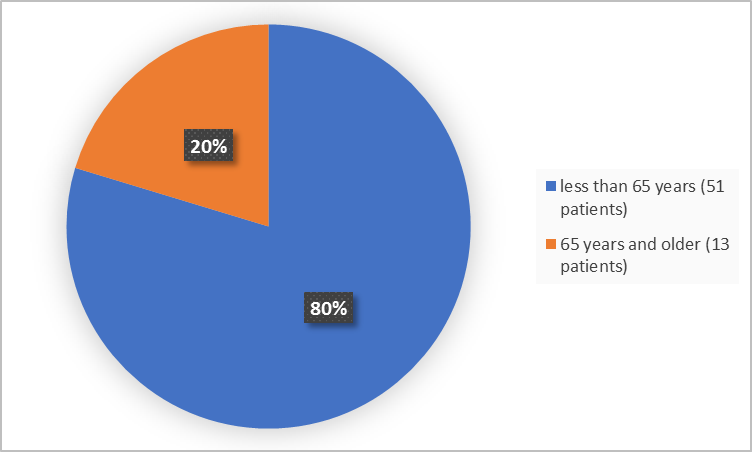Drug Trial Snapshot: FIRDAPSE
HOW TO USE THIS SNAPSHOT
The information provided in Snapshots highlights who participated in the clinical trials that supported the FDA approval of this drug, and whether there were differences among sex, race, and age groups. The “MORE INFO” bar shows more detailed, technical content for each section. The Snapshot is intended as one tool for consumers to use when discussing the risks and benefits of the drugs.
LIMITATIONS OF THIS SNAPSHOT:
Do not rely on Snapshots to make decisions regarding medical care. Always speak to your health provider about the risks and benefits of a drug. Refer to FIRDAPSE for complete information.
FIRDAPSE (amifampridine)
FIR-dapse
Catalyst Pharmaceuticals, Inc.
Approval date: November 28, 2018
DRUG TRIALS SNAPSHOT SUMMARY:
What is the drug for?
FIRDAPSE is a drug for the treatment of Lambert-Eaton myasthenic syndrome (LEMS) in adults. LEMS is a rare disease in which the immune system attacks the connection between nerves and muscles, causing muscle weakness. Sometimes, LEMS arises as a result of cancer elsewhere in the body (condition known as paraneoplastic syndrome).
How is this drug used?
FIRDAPSE is a tablet that is taken three to four times a day by mouth.
What are the benefits of this drug?
Patients taking FIRDAPSE experienced less muscle weakness and had improved physical well-being in comparison to patients who were treated with placebo.
What are the benefits of this drug (results of trials used to assess efficacy)?
The tables below summarize efficacy results for the Clinical Trials 1 and 2 separately. The two co-primary measures of efficacy in both trials were the change from baseline to the end of the discontinuation period in the Quantitative Myasthenia Gravis (QMG) score and in the Subject Global Impression (SGI) score.
The QMG is a 13-item physician-rated categorical scale assessing muscle weakness. Scores range from 0 (no impairment) to 39 (worst impairment). The SGI is a 7-point scale on which patients rated their global impression of the effects of the study treatment on their physical well-being. SGI scores range from 0 (least perceived benefit) to 7 (most perceived benefit).
Table 2. Change from Baseline to Day 14 in QMG Score and SGI Score in Trial 1
|
Assessment |
FIRDAPSE (n=16) |
Placebo (n=21) |
|---|---|---|
|
Primary Endpoints |
||
|
QMG Scorea |
||
|
Baseline |
6.4 |
5.6 |
|
Change from Baseline |
0.4 |
2.2 |
|
FIRDAPSE-placebo Treatment Difference (Least Square Mean (95% CI) |
–1.7 (–3.4, –0.0) |
|
|
p-valuec |
0.045 |
|
|
SGI Scoreb |
||
|
Baseline |
5.6 |
5.9 |
|
Change from Baseline (Least Square Mean ) |
-0.8 |
-2.6 |
|
FIRDAPSE-placebo Treatment Difference, (Least Square Mean (95% CI) |
1.8 (0.7, 3.0) |
|
|
p-valuec |
0.003 |
|
a. QMG Score range 0 (no impairment) to 39 (worst impairment)
b. SGI Score range 0 (least perceived benefit) to 7 (most perceived benefit)
c. Pairwise contrast at Day 14 from mixed-effects model with repeated measures.
Table 3. Change from Baseline to Day 4 in QMG Scores and SGI Scores in Trial 2
|
Assessment |
FIRDAPSE (n=13) |
Placebo (n=13) |
|---|---|---|
|
QMG Scoresa |
||
|
Baseline, Mean |
7.8 |
8.5 |
|
Change from Baseline, Least Square Meanc |
0.00 |
6.54 |
|
FIRDAPSE-placebo Treatment Difference, Least Square Mean (95% CI) |
‑6.54 (‑9.78, ‑3.29) |
|
|
p-valued |
0.0004 |
|
|
SGI Scoresb |
||
|
Baseline, Mean |
6.1 |
5.8 |
|
Change from Baseline, |
-0.64 |
-3.59 |
|
FIRDAPSE-placebo Treatment Difference, Least Square Mean (95% CI) |
2.95 (1.53, 4.38) |
|
|
p-valued |
0.0003 |
|
a QMG Score range 0 (no impairment) to 39 (worst impairment)
b.SGI Score range 0 (least perceived benefit) to 7 (most perceived benefit)
c. Change from baseline for QMG total score was modeled as the response, with fixed effects terms for treatment and QMG at Baseline.
d. p-value based on the Wilcoxon Rank Sum Test for treatment differences.
FIRDAPSE Prescribing Information
Were there any differences in how well the drug worked in clinical trials among sex, race and age?
- Sex: There were more women than men in FIRDAPSE clinical trials. Differences in response to FIRDAPSE between men and women could not be determined because of the small number of patients.
- Race: Most patients in the clinical trials were White. Differences in response to FIRDAPSE among races could not be determined because of the small number of patients of other races.
- Age: Most patients in the clinical trials were younger than 65 years of age. Differences in response to FIRDAPSE between patients below and above 65 years of age could not be determined.
Were there any differences in how well the drug worked in clinical trials among sex, race, and age groups?
The tables below summarize efficacy results by subgroup for the QMG and SGI endpoint, respectively.
Table 4. Integrated Analysis of QMG in Demographic Groups
|
Demographic Group |
FIRDAPSE (n = 29) |
Placebo (n = 35) |
|---|---|---|
|
Sex: Men |
||
|
n |
13 |
12 |
|
LS mean (SE) |
–0.07 (0.91) |
3.83 (0.95) |
|
LS mean difference (95% CI) |
–3.90 (–6.74, –1.07) |
|
|
p-value |
0.009 |
|
|
Sex: Women |
||
|
n |
16 |
23 |
|
LS mean (SE) |
0.39 (0.99) |
3.99 (0.82) |
|
LS mean difference (95% CI) |
–3.60 (–6.23, –0.98) |
|
|
p-value |
0.009 |
|
|
Race: White |
||
|
N |
23 |
34 |
|
LS mean (SE) |
0.28 (0.79) |
4.02 (0.65) |
|
LS mean difference (95% CI) |
–3.74 (–5.80, –1.68) |
|
|
p-value |
<0.001 |
|
|
Race: Other |
||
|
n |
5 |
0 |
|
LS mean (SE) |
–0.40 (0.42) |
Not available |
|
Age: <65 years |
||
|
N |
23 |
28 |
|
LS mean (SE) |
0.39 (0.79) |
4.14 (0.72) |
|
LS mean difference (95% CI) |
–3.75 (–5.91, –1.60) |
|
|
p-value |
0.001 |
|
|
Age: ≥65 years |
|
|
|
N |
6 |
7 |
|
LS mean (SE) |
–1.23 (1.42) |
3.62 (1.29) |
|
LS mean difference (95% CI) |
–4.85 (–9.72, 0.02) |
|
|
p-value |
0.051 |
|
|
LS mean difference (95% CI) |
Not available |
|
|
p-value |
Not available |
|
LS = least square
CI = confidence interval.
SE = standard error
Adapted from FDA Review
Table 5. Integrated Analysis of SGI in Demographic Groups
|
Demographic Group |
FIRDAPSE (n = 29) |
Placebo (n = 35) |
|---|---|---|
|
Sex: Men |
||
|
N |
13 |
12 |
|
LS mean (SE) |
-0.49 (0.48) |
-3.05 (0.50) |
|
LS mean difference (95% CI) |
2.56 (1.13, 3.99) |
|
|
p-value |
0.001 |
|
|
Sex: Women |
||
|
n |
16 |
23 |
|
LS mean (SE) |
-0.95 (0.44) |
-2.95 (0.36) |
|
LS mean difference (95% CI) |
2.00 (0.84, 3.15) |
|
|
p-value |
0.001 |
|
|
Race: White |
||
|
N |
23 |
34 |
|
LS mean (SE) |
-0.94 (0.37) |
-3.01 (0.31) |
|
LS mean difference (95% CI) |
2.08 (1.11, 3.04) |
|
|
p-value |
<0.001 |
|
|
Race: Other |
||
|
N |
5 |
0 |
|
LS mean (SE) |
0.00 (0.20) |
|
|
LS mean difference (95% CI) |
Not available |
|
|
p-value |
Not available |
|
|
Age: <65 years |
|
|
|
N |
23 |
28 |
|
LS mean (SE) |
-0.99 (0.34) |
-3.37 (0.30) |
|
LS mean difference (95% CI) |
2.38 (1.46, 3.29) |
|
|
p-value |
<0.001 |
|
|
Age: ≥65 years |
|
|
|
N |
6 |
7 |
|
LS mean (SE) |
-0.09 (0.75) |
-1.21 (0.69) |
|
LS mean difference (95% CI) |
1.12 (-1.24, 3.48) |
|
|
p-value |
0.315 |
|
LS = least square
CI = confidence interval.
SE = standard error
Adapted from FDA Review
What are the possible side effects?
FIRDAPSE may cause serious side effects, including seizures and severe allergic reactions.
The most common side effects of FIRDAPSE are tingling around the mouth, tongue, face, fingers, toes, and other body parts, upper respiratory infection, stomach pain, nausea, diarrhea, headache, increased liver enzymes, back pain, high blood pressure and muscle spasms.
What are the possible side effects (results of trials used to assess safety)?
The table below summarizes adverse reactions that occurred in patients newly treated with FIRDAPSE in Trial 1.
Table 7. Adverse Reactions in ≥5% of LEMS Patients Newly Treated with FIRDAPSE in Trial 1
|
Adverse Reaction |
FIRDAPSE |
|---|---|
|
Paresthesia* |
62 |
|
Upper respiratory tract infection |
33 |
|
Abdominal pain |
14 |
|
Nausea |
14 |
|
Diarrhea |
14 |
|
Headache |
14 |
|
Elevated liver enzymes** |
14 |
|
Back pain |
14 |
|
Hypertension |
12 |
|
Muscle spasms |
12 |
|
Dizziness |
10 |
|
Asthenia |
10 |
|
Muscular weakness |
10 |
|
Pain in extremity |
10 |
|
Cataract |
10 |
|
Constipation |
7 |
|
Bronchitis |
7 |
|
Fall |
7 |
|
Lymphadenopathy |
7 |
|
Bronchitis |
7 |
*Includes paresthesia, oral paresthesia, oral hypoesthesia
**Includes elevated alanine aminotransferase (ALT), aspartate aminotransferase (AST), lactate dehydrogenase (LDH), and gamma-glutamyl transferase (GGT)
FIRDAPSE Prescribing Information
Were there any differences in side effects among sex, race and age?
- Sex: There were more women than men in FIRDAPSE clinical trials. Differences in side effects between men and women could not be determined because of the small number of patients.
- Race: Most patients in the clinicals trial were White. Differences in side effects among races could not be determined because of the small number of patients of other races.
- Age: Most patients in the clinical trials were younger than 65 years of age. Differences in side effects between patients below and above 65 years of age could not be determined.
Were there any differences in side effects of the clinical trials among sex, race, and age groups?
The table below summarizes selected adverse events by subgroup that occurred in patients newly treated with FIRDAPSE.
Table 8. Adverse Reactions in Patients Newly Treated with FIRDAPSE in Trial 1
|
Adverse Event (AE) |
Sex |
Race |
Age |
|||
|---|---|---|---|---|---|---|
|
Men |
Women |
White |
All other |
<65 years |
≥65 years |
|
|
Paresthesia |
6 (40) |
20 (74) |
24 (62) |
2 (67) |
18 (60) |
8 (67) |
|
Upper Respiratory Infections |
7 (47) |
8 (30) |
13 (33) |
2 (67) |
11 (37) |
4 (33) |
Clinical Trial Report
WHO WAS IN THE STUDIES?
Who participated in the clinical trials?
The FDA approved FIRDAPSE based on evidence from two clinical trials (Trial 1/NCT01377922 and Trial 2/ NCT02970162) of 64 patients with LEMS. The trials were conducted at 16 sites in 8 countries, including France, Germany, Hungary, Poland, Russia, Serbia, Spain, and the United States.
The figure below summarizes how many men and women were in the clinical trials.
Figure 1. Baseline Demographics by Sex
Clinical Trial Data
Figure 2 and Table 1 below summarize the percentage of patients by race enrolled in the clinical trials.
Figure 2. Baseline Demographics by Race
Clinical Trial Data
Table 1. Baseline Demographics by Race
|
Race |
Number of Patients |
Percentage |
|---|---|---|
|
White |
57 |
89 |
|
Black or African American |
1 |
1 |
|
Asian |
1 |
1 |
|
All Other |
5 |
8 |
Figure 3 summarizes the percentage of patients by age enrolled in the clinical trials.
Figure 3. Baseline Demographics by Age
Clinical Trial Data
The table below summarizes demographics of patients in the clinical trials.
Table 9. Baseline Demographics of Patients in the Clinical Trials
|
Demographic Parameter |
Trial 1 |
Trial 2 |
Total |
|---|---|---|---|
|
Sex |
|||
|
Men |
15 (39) |
10 (39) |
25 (39) |
|
Women |
23 (61) |
16 (61) |
39 (61) |
|
Race |
|||
|
White |
34 (90) |
23 (88) |
57 (89) |
|
Black or African American |
0 |
1(4) |
1(1) |
|
Asian |
0 |
1(4) |
1 (1) |
|
Other |
2 (5) |
1 (4) |
3 (5) |
|
Not reported |
2 (5) |
0 |
2 (3) |
|
Age (years) |
|||
|
Median (min, max) |
54 (21,88) |
54 (31,75) |
54 (21,88) |
|
Age Group |
|||
|
<65 years |
31 (82) |
20 (77) |
51 (80) |
|
≥65 years |
7 (18) |
6 (23) |
13 (20) |
|
Ethnicity |
|||
|
Hispanic or Latino |
3 (8) |
5 (19) |
8 (13) |
|
Not Hispanic or Latino |
34 (90) |
21 (81) |
55 (86) |
|
Not reported |
1 (2) |
0 |
1(1) |
|
Geographic Region |
|||
|
US |
13 (34) |
26 (100) |
39 (61) |
|
Europe/Russia |
25 (66) |
0 |
25 (39) |
Clinical Trial Data
How were the trials designed?
The benefit and side effects of FIRDAPSE were evaluated in two clinical trials of patients with LEMS. All patients initially received FIRDAPSE, and when the dose was deemed to be adequate, were randomized to continue receiving FIRDAPSE, or be switched to placebo. From the time of randomization, until the completion of the study, neither the patients nor the healthcare providers knew whether FIRDAPSE or placebo was being given.
The benefit of FIRDAPSE was evaluated by measuring the difference in muscle weakness and overall well-being for the patients receiving FIRDAPSE in comparison to the patients who took placebo. In the first trials that measurement was taken at Day 14 of the randomized treatment, and in the second trial, on Day 4 of the randomized treatment.
How were the trials designed?
The efficacy of FIRDAPSE for the treatment of LEMS was evaluated in two randomized, double-blind, placebo-controlled trials. The trials enrolled patients 21 to 88 years old with a confirmed diagnosis of LEMS based on either neurophysiology studies or a positive anti-P/Q type voltage-gated calcium channel antibody test.
In Trial 1, after an initial run-in phase on FIRDAPSE, patients were randomized (approximately 1:1) in double-blind fashion to either continue treatment with FIRDAPSE or to down titrate to placebo over 7 days. Following the downward titration period, patients remained on blinded FIRDAPSE or placebo for 7 more days.Efficacy was assessed at Day 14 of the double-blind period.
In Trial 2, patients on stable treatment with FIRDAPSE were randomized 1:1 in a double-blind fashion to either continue treatment with FIRDAPSE or change to placebo for 4 days. Efficacy was assessed at the end of the 4-day double-blind discontinuation period.
The two co-primary measures of efficacy in both trials were the change from baseline to the end of the discontinuation period in the Quantitative Myasthenia Gravis (QMG) score and in the Subject Global Impression (SGI) score.
The QMG is a 13-item physician-rated categorical scale assessing muscle weakness. Each item is assessed on a 4-point scale, where a score of 0 represents no weakness, and a score of 3 represents severe weakness (total score 0-39). Higher scores represent greater impairment.
The SGI is a 7-point scale on which patients rated their global impression of the effects of the study treatment on their physical well-being. Lower scores on the SGI represent lower perceived benefit with the study treatment.
GLOSSARY
CLINICAL TRIAL: Voluntary research studies conducted in people and designed to answer specific questions about the safety or effectiveness of drugs, vaccines, other therapies, or new ways of using existing treatments.
COMPARATOR: A previously available treatment or placebo used in clinical trials that is compared to the actual drug being tested.
EFFICACY: How well the drug achieves the desired response when it is taken as described in a controlled clinical setting, such as during a clinical trial.
PLACEBO: An inactive substance or “sugar pill” that looks the same as, and is given the same way as, an active drug or treatment being tested. The effects of the active drug or treatment are compared to the effects of the placebo.
SUBGROUP: A subset of the population studied in a clinical trial. Demographic subsets include sex, race, and age groups.
LINK TO PRESCRIBING INFORMATION



